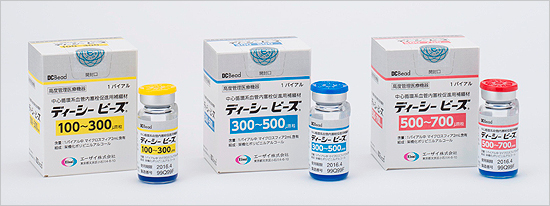- For Print
- February 3, 2014
Eisai Co., Ltd. (Headquarters: Tokyo, President & CEO: Haruo Naito, “Eisai”) announced today that it will launch the vascular embolization device DC Bead® (specially controlled medical device) in Japan on February 4.
DC Bead contains hydrophilic microspheres made from cross-linked polyvinyl alcohol polymer. Developed by Biocompatibles UK Limited (Biocompatibles), a BTG International group company, as an intravascular embolization device, it is injected via catheter into targeted blood vessels to achieve selective embolization. DC Bead is already marketed as an effective embolization device in the treatment of hepatocellular carcinoma (HCC) and other hypervascularized tumors in more than 50 countries and territories worldwide, including in Europe and the United States.
Eisai acquired the exclusive rights to develop and market DC Bead in Japan from Biocompatibles in July 2009 and received manufacturing and marketing authorization for the device from Japan's Ministry of Health, Labour and Welfare in April 2013 for use in transcatheter arterial embolization (TAE) in patients with HCC. On February 1, 2014, DC Bead was classified in the Special Treatment Materials (STM) category for medical device reimbursement under the country's National Health Insurance system.
In Japan, the Eisai Group markets a diverse range of medical devices and pharmaceuticals for the diagnosis and treatment of liver diseases. These products include the non-ionic contrast medium Iomeron® and non-ionic contrast medium for MRI ProHance®, both of which are imaging devices used in HCC diagnosis, the in-vitro diagnostic tool PIVKA-Ⅱ Kit, which is used to measure the HCC marker PIVKA-Ⅱ/DCP, and two liver disease medications and anti-allergy agents, Stronger Neo-Minophagen® C and Glycyron® Tablets. Through the launch of DC Bead in Japan, Eisai seeks to further enhance its liver disease product portfolio in the country as well as continue to contribute to addressing the diverse needs of, and increasing the benefits provided to, patients with HCC and their families.
[ Please refer to the following notes for a product outline,
further information on DC Bead and TAE, and a product photograph. ]
< Notes to editors >
1. Product Outline
1) Product Name:
DC Bead®
2) Ministry of Health, Labour and Welfare Special Treatment Materials (STM) Classification:
183. Intravascular embolization materials (3) For transcatheter arterial chemo-embolization
3) National Health Insurance Reimbursement Price Listing Based on above Classification:
99,000 yen
4) Indication for Use:
Transcatheter arterial embolization therapy in patients with hepatocellular carcinoma (HCC)
5) Bead Size and Dose:
DC Bead is available in three bead sizes (100-300 µm, 300-500 µm, and 500-700 µm) so that an appropriate bead size can be selected based on vascular diameter, tumor size and extent of intended embolization in the targeted blood vessel. Bead size and dose volume should be also determined based on medical imaging of blood circulation in the area of the targeted vessel. Overall dose per embolization procedure should normally be one vial (2 mL of DC Bead), but in cases where the vascular diameter and extent of intended embolization are determined to require a larger dose, a maximum of two vials (4 mL of DC Bead) is advised.
6) Packaging:
- 100-300 µm: 1 vial of solution containing 2 mL of DC Bead per box
- 300-500 µm: 1 vial of solution containing 2 mL of DC Bead per box
- 500-700 µm: 1 vial of solution containing 2 mL of DC Bead per box
2. About DC Bead
DC Bead contains hydrophilic microspheres (beads) produced made from cross-linked polyvinyl alcohol polymer. As a vascular embolization device, it is injected via catheter into targeted blood vessels to achieve selective embolization. Due to the beads being both microscopic and uniformly spherical, DC Bead allows for sustained embolization of targeted blood vessels based on vascular diameter and tumor size, with each embolization procedure confirmed through endoscopic observation of the targeted vessels. Following its launch in Japan, the device will be domestically available in three bead sizes (100-300 µm, 300-500 µm, and 500-700 µm) so that an appropriate bead size can be selected based on vascular diameter, tumor size and extent of intended embolization in the targeted blood vessel.
In addition to DC Bead's indication in Japan for transcatheter arterial embolization (TAE) therapy in patients with hepatocellular carcinoma (HCC), Eisai is currently conducting Phase Ⅲ clinical trials of DC Bead in Japan as an effective embolization device for treating other hypervascularized tumors*.
- *Hypervascularized tumors most commonly refer to hepatocellular carcinoma (HCC), renal cell carcinoma, bone and soft tissue sarcoma, and other tumors that receive nourishment via a sophisticated vascular network formed in tumor tissue.
3. About Transcatheter Arterial Embolization (TAE)
TAE is a therapy that selectively obstructs blood circulation to induce necrosis in hepatocellular carcinoma (HCC) by injecting embolization material into the hepatic artery, the artery that supplies nutrient blood to the tumor. In contrast to healthy liver cells, which receive blood from both the hepatic artery and portal vein, HCC cells receive blood mainly from the hepatic artery via a vascular network formed in the tumor tissue. Consequently, by using embolizing material to selectively embolize blood vessels in the hepatic artery, selective necrosis can be more effectively induced at the tumor site. There are two types of TAE therapy: one involving embolization without chemotherapy, and transcatheter arterial chemo-embolization (TACE), the latter of which is performed in combination with chemotherapeutic agents to suppress cancer cell activity.
4. Product Photograph

